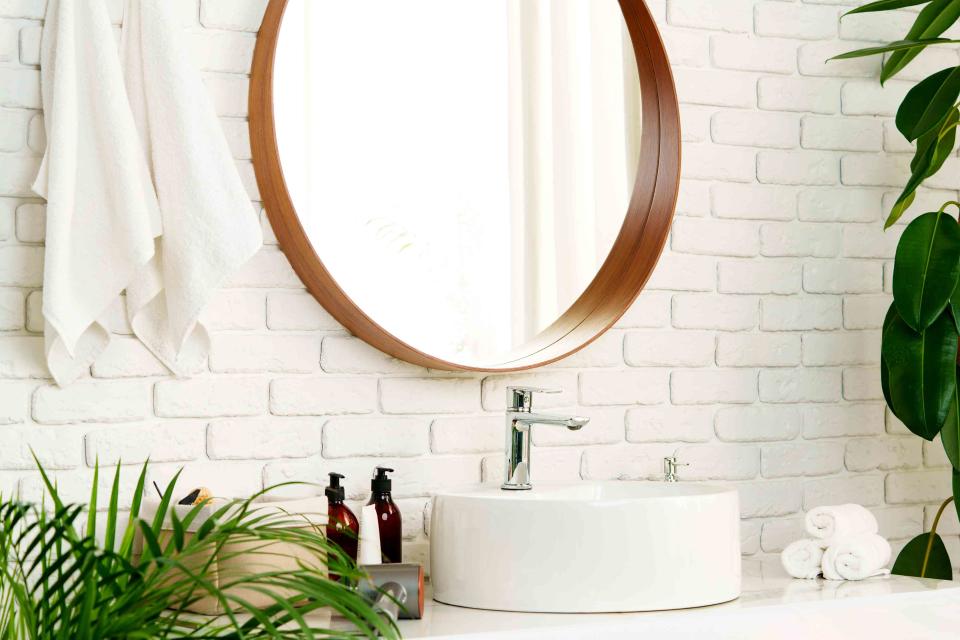7 Cleaning Mistakes That Always Lead to Streaky Mirrors, According to Pros
Banish less-than-perfect reflections with these expert tips.

FabrikaCr / Getty Images
Polishing a mirror is a seemingly straightforward task, yet many people still fail to achieve crystal clear results they’re after. Folks will spend hours meticulously deep-cleaning their homes, only to catch a glimpse of some ghostly streaks on the bathroom vanity right before bed. (Truly, there’s nothing more frustrating than that!)
But maybe the oversimplification of this chore is what’s resulting in those irksome phantom smears—your indiscriminate cleaning habits might actually be the reason your vanity looks dirtier after you’ve wiped it down. So, we asked cleaning experts to zero in on mistakes they see people make when it comes to shining mirrors, and how to fix them so streaky, cloudy glass is a thing of the past.
Related: 10 Genius Cleaning Hacks That Will Make Your Life Easier
Meet Our Expert
Melissa Maker, content creator behind Clean My Space and owner of a Toronto-based cleaning company
Brandon Pleshek, third generation janitor and content creator behind Clean That Up!
You’re Not Pre-Cleaning Your Mirror
This may seem like an annoying extra step, but it will make the final result look absolutely pristine—we promise. Melissa Maker, the content creator behind Clean My Space and owner of a Toronto-based cleaning company, says if the mirror is dirty, remove the dust first with a dry microfiber cloth so as not to wet the dust and make it stick to the mirror. “You may also have luck reducing streaks by removing toothpaste or other build-up with a bit of vinegar or rubbing alcohol first; that way, it doesn't streak everything else,” she suggests.
You’re Not Using a Two-Towel System
According to Brandon Pleshek, a third generation janitor and the content creator behind Clean That Up!, most people do a single pass to clean… and it looks great at first, but then they return later and the mirrors are cloudy and loaded with streaks from moisture left behind. He recommends using a two-towel system—one cloth to clean and then a dry cloth to buff out any streaks. “This is the most forgotten step. Not buffing with a dry microfiber towel after cleaning is what leaves those streaks behind. It's truly the key!” Pleshek stresses.
You’re Using The Wrong Cloth (and It’s Probably Dirty)
The consensus is that paper towels are kind of the worst for cleaning mirrors. They shed so much lint and can be wasteful. Maker adds, “Rags are also not absorbent and leave streaks behind.” So what’s the perfect product? According to both Maker and Pleshek, microfiber towels will guarantee spotless mirrors.
Maker specifically recommends a flat-weave microfiber cloth. These lift grease and dirt, absorb liquid, and leave a streak-free shine behind. She adds that it’s imperative you use a clean cloth—don’t use the same cloth you used to wipe 12 other surfaces in your house. Otherwise, you’re just dragging dirt across your mirrors.
You’re Spraying Your Cloth Instead of the Mirror
Okay, this is a little surprising and may be contradictory to what you’ve heard in the past, but according to both Maker and Pleshek, you should actually spray the mirror directly. Simply put, Maker says, “Spraying a cloth just won't get you enough cleaning power.” And Pleshek explains, “This will ensure full coverage of the cleaner on all parts of the surface and that it's completely cleaned—no areas are missed. It can be irritating if the towel doesn't have sufficient cleaner applied and dries out before you can clean the mirror in its entirety.”
The big concern people have with this practice is that cleaning fluid might drip into the mirror frame (which is what creates those dark, black spots you sometimes see around the edges Maker explains), but If you work quickly enough, you can avoid this problem.
And You Might Not Be Using Enough Product
Related to the last point, if you’re not spraying enough product on your mirror, you might notice some streaking. As for specific product recommendations from our experts, Pleshek prefers Sprayway, because it’s ammonia-free and easy to use. (“And the bubbles look cool!”)
Maker suggests you could even make your own at home though. “I have been using equal parts white vinegar and water for years with great success. If you have build-up on your mirror (e.g., toothpaste), consider adding a teaspoon of cornstarch to the solution. The fine grit of cornstarch helps to abrade gunk without scratching the mirror finish,” she says.
Related: The 11 Best Glass Cleaners of 2024 for Streak-Free Windows, Mirrors, and More
Tips
This depends on the set-up, but in your bathroom, if you’ve got vanity lights, they might be sabotaging your work. Pleshek says, “Sometimes it can be helpful to turn the bathroom vanity lights off when cleaning the mirror. The heat can dry the cleaner before you can get to it.” That annoying quick-dry feature you didn’t ask for could result in streaks!
You’re Wiping in Circular Motions
According to Maker, wiping in circular motions is a bad idea. Why? It’s just spreading dirt back over the area you just cleaned! “Use the ‘S’ pattern, starting at the top right corner, moving over to the top left corner, and then sweeping slightly down to reverse your tracks until you reach the bottom. This reduces streaking,” she advises.
You’re Walking Away Without a Second Glance
The very last step you should take before you wrap up is tilting your head and inspecting the mirror at an angle (ideally with the lights on)—this will allow you to spot any streaks. They’re easy to miss sometimes if you’re looking directly at the mirror or if the room isn’t well-lit.
Related: How to Clean Glass Shower Doors So They Sparkle
For more Real Simple news, make sure to sign up for our newsletter!
Read the original article on Real Simple.


